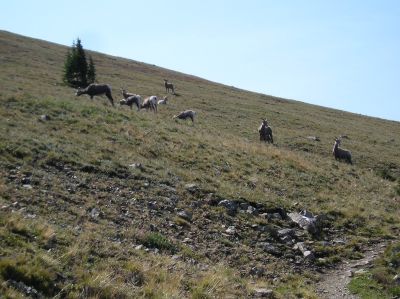
*The hike - tales from an asthmatic high altitude junkie*
"Every man has to know his limitations."
So Clint Eastwood said in "Dirty Harry." Thanks to a trip out to New Mexico to summit Mt. Wheeler, one of the highest non-technical highpoints in the US, I now know mine - at least in regards to high altitude hiking - which is just above 13,000 feet. Mt. Wheeler is the highest peak in New Mexico and is located near the town of Taos near the Colorado border. The area is filled with the Southern Rockies and is pretty rugged. For whatever reason, I am attracted to rugged places with beautiful views. I also suffer from asthma which kinda puts some limits on things. As with all things, embarking on one of these kinds of adventures when you have asthma is nothing more than a gamblerís calculated risk - you might make it and you might not. All you can do it play the odds.
This last September, I decided to make a second attempt at the Wheeler summit. Two years earlier a bud and I were turned back by heavy snow and foul conditions. Learning from that mistake, I decided to go two weeks earlier which prior research indicated that the peaks should be snow free and much easier to trek. I also decided to fly out there and rent a car rather than drive. Driving for more than a day non-stop tends to tire me out. And I know that when I am tired, I cannot hike as well. Plus the need to acclimate to a higher altitude is important and flying out there would give me a chance to do so for a couple extra days.
On the first day, the climb to 10,000 feet from around 7,700 was relatively uneventful other than the fact that as a flatlander from sea level, I had not acclimated properly to the altitude and had to take it easy. Oh well, we choose our battles. Other than a smattering of light rain, conditions were excellent. Not without lots of huffing and puffing, I made it to a good starting point for the next dayís ascent. I made camp near a nice fast-flowing stream in a hollow secluded from the main trail. I call it stealth camping - pitching a camp on a small footprint out of sight from all but deliberate seekers. I enjoy privacy on these hikes - I see people everyday at work but hiking is MY time to be anti-social and alone if I want to be.
The campsite had access to plenty of water. What I am going to say is going to freak some people out so be prepared - you do not have to treat EVERY water source you drink from. As a matter of fact, I rarely treat water in the backcountry, preferring to drink directly from streams. What I do is assess the situation and make an informed decision. First I consider the altitude - above 10,000 or above the treeline you just arenít going to have many problems. Dehydration is a MUCH worse problem than treating every water source. So I tend to drink freely and have yet to suffer from it. This does not apply to other countries outside of the US and Canada. In South America or the Caribbean, I treat ALL drinking water - including tap water. Nor does it apply to low altitude areas in the US or Canada.
Comfort and shelter from the winds are the two most important criteria I judge high altitude campsites against. You MUST have shelter from the wind. High winds can shred the best four-season tents if they are improperly pitched. You also want level ground - I doní t sleep well if I am constantly sliding off my sleeping pad or the blood is rushing to my head because my feet are elevated higher than my head. That night I slept pretty well and the temp was higher than expected which I didnít really care for because I like lower temperatures when I sleep out.
On the second day, I got an early start got moving around 7 am - from where I camped, the hike was going to be around 16 miles round trip - that distance is tough for me at high altitude in the mountains with lots of elevation gain and loss over the route. Now that I had spent a night at altitude, my body had acclimated somewhat and the hike wasnít nearly as taxing as it was the day before. I knew to make the summit I would have to travel light and fast so I left most of my gear at the campsite. This was a very calculated risk but one I was willing to take because I knew more than likely I could make it back to the camp before dark. I took my pack, foul weather gear, non-cook food, water, fire-making supplies, my kukri, headlamp and some other smaller items along with my asthma medications. When I am on such a hike, I like to take it in stages, sort of like a rocket. You carry all the heavy gear to a certain altitude, then you discard some of it as you being the next stage and so on.
Sixteen miles in the mountains is a LONG way. On the first four-mile leg of the hike, which took me to a false highpoint, the elevation gain was steady. Water was plentiful and there was no snow - I timed my trip to start and end before the first heavy snows hit the last week of September. The trail was easy to hike - very well marked, unobstructed and lightly traveled. In reality it just took a lot of walking to get to the summit - and I mean a LOT of walking! Morning turned into afternoon and lunch time and I still hadnít made it to the top of the false summit. I was a bit worried at the time because it was getting late but I kept reminding myself that this was the toughest part of the hike - up a seemingly endless series of switchbacks.
Along the way of the first leg, I encountered some very friendly medium-sized grey and black birds which competed for my trail mix at rest stops, an elk, some big horned sheep, a mule deer, several marmots and a hawk which occasionally circled overhead. The weather was exceptional - no clouds and a high of around 60 degrees during the middle of the day. Although the temp was not high, I was sweating pretty profusely because of the exertion. My synth t-shirt wicked off the excess moisture extremely well. My LL Bean Crestas were up to the task and also once again my physical conditioning was equal to the challenge.
As the day wore on, I stripped off some clothes. First the fleece vest, then the silkweight long underwear until I was only wearing a pair of shorts and a synthetic t-shirt. I was still sweating and had to adjust my drink accordingly. What started out as a hike had turned into an endurance contest as the altitude increased. I trudged on and on, one step in front of the other at a slow pace so as not to wear myself out too quickly.
At around 1300 I finally made it to the top of the false summit - if you didnít know any better you would think it was the peak - and then stared down into the valley - I was going to have to loose around 2,000 feet of elevation before beginning the ascent again. Let me tell you this was disheartening. I sat down, took off my boots, drank a whole bunch of water, ate a Cliff bar and just relaxed for around 15 minutes. No nap at home had ever felt as good as this rest stop. This stop gave me the energy and mindset to go on. At this stage, it would have been VERY easy to stop and go back. I had gone farther than I had ever gone before. But the stop had reinvigorated my resolve as well as my body. I vowed to make it to the top.
During the ascent, at around 12,000 feet, I started developing symptoms of mild altitude sickness - a very slight headache and some irritability. I still had several miles to go to make it to the summit. Knowing I didnít have much time left - both chronologically in the day and in my stamina - I ditched everything by my water bottle - and planned to pick it up on the descent back to camp. I hiked on. I also took a Diamox - an altitude sickness remedy. It is not to be used for serious altitude sickness, but I knew I didnít have a serious case. At around 12,500 feet, I began to get a bit dizzy and a bit disconcerted. I knew the summit was close - the trail had grown steeper, but I could not see it. Quickly I realized I had made it to the top of the "false" peak - which many people think it the actual summit. It is called Mt, Walter and rises 13,080 feet. I looked around and could not find the real summit. I knew from research that it was close, but the only trail I could readily see was one that started descending. My heart bottomed out. My thinking was clouded. Never the less, I still possessed the fiery determination to make it no matter what the costs. I was SO close.
At that point I made the decision - I was going to make it to the top or die trying. Literally. I left my water bottle at Mt. Walter and I was completely unencumbered. Either I made the summit or someone would find my freeze-dried remains. So I started down and hiked nearly a mile farther until I realized I had passed the real summit! Painfully but hopefully, I started backtracking until I found a poorly marked trail which led me to the actual summit. For the first time I heaved a sigh of relief when I saw the marker and a cairn - Mt. Wheeler 13,161 feet. I milled around on the top for a while and signed the ledger and took a few photos. My mind cleared and weariness left me. It was time to break for camp and a good hot meal.
The remaining descents and ascents required to get back to camp were just simple, time consuming walking again. I had made it. At Mt. Walter I retrieved my water bottle - and drained it. There was plenty of water on the way back to camp to refill it from. From monitoring my urine output and color, I knew I had become slightly dehydrated. Next I found my pack and ate a quick mini-meal of peanut butter and jelly and honey on a tortilla.
I rolled into camp around 18:30 - nearly 12 hours on the trail. I slept well but developed a nasty case of asthma. I have suffered from asthma for most of my 38 years so I generally stay well prepared to deal with flare-ups. So I treated it with some prednisone (medrol) from a dose pack and started a round of antibiotics (generally when you take prednisone for a respiratory condition which generates a lot of mucous you need an antibiotic as well because the steroid lowers your resistance. Some doctors will disagree with this as reasonable people can) along with taking an expectorant and going to sleep early. Further I rehydrated continuously during the night. High altitude and dry air tends to dehydrate you and this in turn exacerbates asthma. The prednisone worked its magic and I slept well. The next day I took it easy walking down the mountain the last two miles to my vehicle.

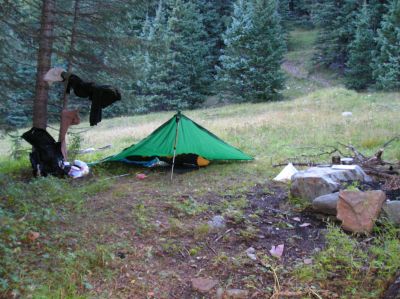
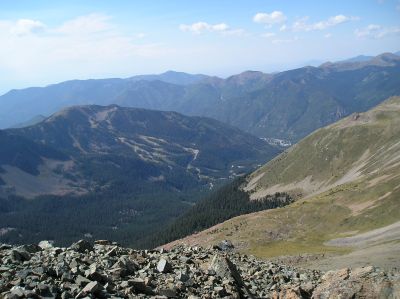
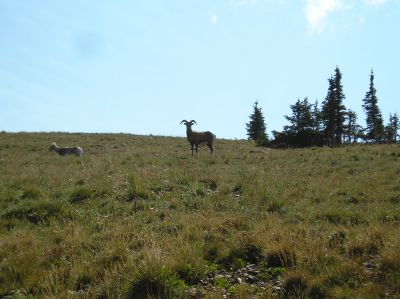
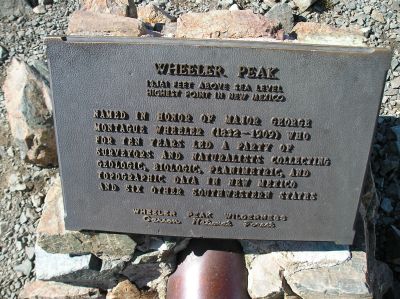
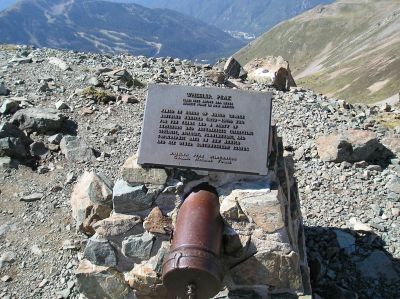
Gear analysis
Three things make serious backcountry hiking successful - conditioning, experience and equipment.
Overall, my equipment served very well. Over time, I have managed to acquire better and more appropriate equipment. I am at the point now where I can hike with whatever equipment I want. I donít care how much money you have, to get the RIGHT gear, you have to try things out and fail, spend money on stuff that doesnít work, spend more money as truly better gear becomes available.
My equipment list:
Kelty West Coast External Frame pack - veteran of many excursions. While the rest of the world insists on internal frame packs - and they do have their place, I find external frame packs more comfortable to walk with. My back does not get as hot and since I plan most of my trips, I do not often find myself seriously bushwacking. I also like the multitude of external pockets and lash points.
Kelty 25-degree Light Year Down Bag - again, veteran of many trips. Although the bag is a little lighter than the 25-degree claimed by the company, it does well to below freezing as long as you stay out of the wind because it has a taffeta outer shell which is more comfortable and breathable, but offers almost zero wind resistance. Very lightweight and packable.
Thermarest self-inflating sleeping pad - a MUST for backcountry trips because it is both comfortable and lifesaving by keeping your body heat from sinking into the ground.
Svea 123 stove - the hikerís classic. Runs on white gas and virtually indestructible. This little solid brass beauty has brewed more tea and cooked more meals than any other in my collection. Although I have more sophisticated and lighter stoves, I find myself taking this one on treks more than any other.
8x10 tarp - simple coated tarp. Relatively light weight and durable. Larger than I really need, but I like extra space to lounge around in during bad weather. Call me decadent. No mosquito netting cause I knew the insects were not going to be bad at that time of year.
LL Bean Cresta boots - midweight leather hiking boots. Not ultra lightweight because I like the extra protection and support they give me. Wool socks - no liners which for me are MUCH more comfortable because liners seem to constrict my feet too tightly.
Light - I used a Black Diamond led headlamp. Bright and easy on batteries it is worth its weight in gold.
Food - carried a variety of food - several apricot Cliff bars that remain soft even in cold weather. These bars have 100 percent of most vitamins you need. Carried a couple of Mountain House meals for quick preparation, some MRE components, peanut butter, jam, tortillas, hot cocoa, mate coca (Peruvian tea), honey for sweetening and other assorted trail mix and condiments. This mix of food kept me full of energy and I was never hungry.
Ken Onion Blackout folder with plain blade and clip - worked well for most camp chores.
Ken Onion Vortex sheath knife with serrated blade and sheath - didnít use it much. Was glad I had it for bigger cutting duties that never arose.
Cold Steel Kukri - for chopping. Worked very well for the small firewood duties I had.
Black Diamond Collapsible hiking poles - one of the best investments a hiker can make.
Other - Compass, blast match, matches, water purification tablets, first aid, paracord, titanium tent stakes, extra socks, a laminate jacket and pants for wind and rain, silk weight capilene long underwear, a polar tech vest, windstopper hat and a down jacket.
Makarov 9x18 and two magazines - one with FMJ and the other loaded with HP. Left in car for weight reasons and perceived lack of threat. I will not bring it with me again as ammo supply is a problem. Next trip will find me carrying either my 1911 or my Ruger P-89.
Stainless Steel Mini-14 .223 and two magazines - one 20 rounder loaded with 62 FMJ and another 20 rounder loaded with 62 SP. Left in car for weight reasons and perceived lack of threat. The mini made me feel better when I was car camping in desolate locales during other parts of my trip that I did not talk about on this trip. Animals do not concern me in New Mexico but some people do.
Postscript
My conditioning regimen exceeded expectations. For six months before the hike, I hit the elliptical machine three times a week to build cardio capacity. Although the hike was hard, and the altitude was tough, I never ran out of cardio capacity.
Also, my medical supplies were adequate. I had to treat one hot spot on my left heel. It never did develop into a blister but I did keep an eye on it. My asthma was treatable and I made it back home and had an examination by my physician. He placed me on a strong prednisone dose for almost a month because the trip had aggravated my lungs. Now, four months after my trip, I am nearly fully up to speed again and back exercising.
Despite the hardships, I am glad I undertook the adventure. I will not do that one again, but there will be others. For me to truly be alive, at times I need a challenge bigger than myself. A challenge where the outcome is not preordained. A challenge that I face alone. The mountains provide these kinds of experiences.
Ajax
www.alpharubicon.com
All materials at this site not otherwise credited are Copyright © 1996 - 2007 Trip Williams. All rights reserved. May be reproduced for personal use only. Use of any material contained herein is subject to stated terms or written permission.